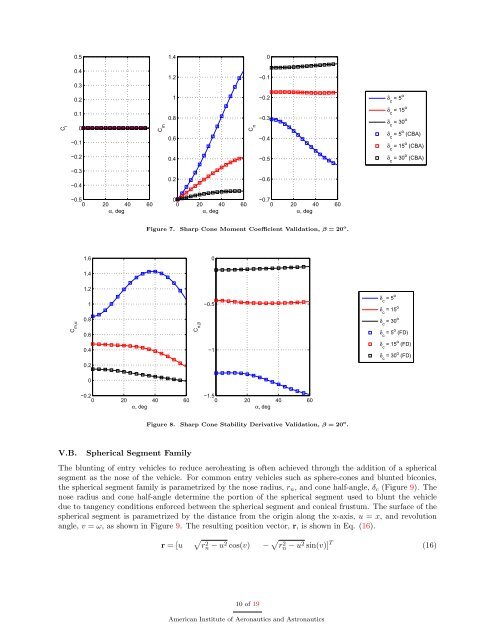Analytic Hypersonic Aerodynamics for Conceptual Design of Entry ...
Analytic Hypersonic Aerodynamics for Conceptual Design of Entry ...
Analytic Hypersonic Aerodynamics for Conceptual Design of Entry ...
You also want an ePaper? Increase the reach of your titles
YUMPU automatically turns print PDFs into web optimized ePapers that Google loves.
C l<br />
0.5<br />
0.4<br />
0.3<br />
0.2<br />
0.1<br />
0<br />
−0.1<br />
−0.2<br />
−0.3<br />
−0.4<br />
−0.5<br />
0 20<br />
α, deg<br />
40 60<br />
C m,α<br />
1.6<br />
1.4<br />
1.2<br />
1<br />
0.8<br />
0.6<br />
0.4<br />
0.2<br />
0<br />
C m<br />
1.4<br />
1.2<br />
1<br />
0.8<br />
0.6<br />
0.4<br />
0.2<br />
−0.2<br />
0 20 40 60<br />
α, deg<br />
V.B. Spherical Segment Family<br />
0<br />
0 20<br />
α, deg<br />
40 60<br />
C n<br />
0<br />
−0.1<br />
−0.2<br />
−0.3<br />
−0.4<br />
−0.5<br />
−0.6<br />
−0.7<br />
0 20<br />
α, deg<br />
40 60<br />
Figure 7. Sharp Cone Moment Coefficient Validation, β = 20 o .<br />
C n,β<br />
0<br />
−0.5<br />
−1<br />
−1.5<br />
0 20 40 60<br />
α, deg<br />
Figure 8. Sharp Cone Stability Derivative Validation, β = 20 o .<br />
δ c = 5 o<br />
δ c = 15 o<br />
δ c = 30 o<br />
δ c = 5 o (CBA)<br />
δ c = 15 o (CBA)<br />
δ c = 30 o (CBA)<br />
δ c = 5 o<br />
δ c = 15 o<br />
δ c = 30 o<br />
δ c = 5 o (FD)<br />
δ c = 15 o (FD)<br />
δ c = 30 o (FD)<br />
The blunting <strong>of</strong> entry vehicles to reduce aeroheating is <strong>of</strong>ten achieved through the addition <strong>of</strong> a spherical<br />
segment as the nose <strong>of</strong> the vehicle. For common entry vehicles such as sphere-cones and blunted biconics,<br />
the spherical segment family is parametrized by the nose radius, rn, and cone half-angle, δc (Figure 9). The<br />
nose radius and cone half-angle determine the portion <strong>of</strong> the spherical segment used to blunt the vehicle<br />
due to tangency conditions en<strong>for</strong>ced between the spherical segment and conical frustum. The surface <strong>of</strong> the<br />
spherical segment is parametrized by the distance from the origin along the x-axis, u = x, and revolution<br />
angle, v = ω, as shown in Figure 9. The resulting position vector, r, is shown in Eq. (16).<br />
r = [u r 2 n − u 2 cos(v) − r 2 n − u 2 sin(v)] T<br />
10 <strong>of</strong> 19<br />
American Institute <strong>of</strong> Aeronautics and Astronautics<br />
(16)

















